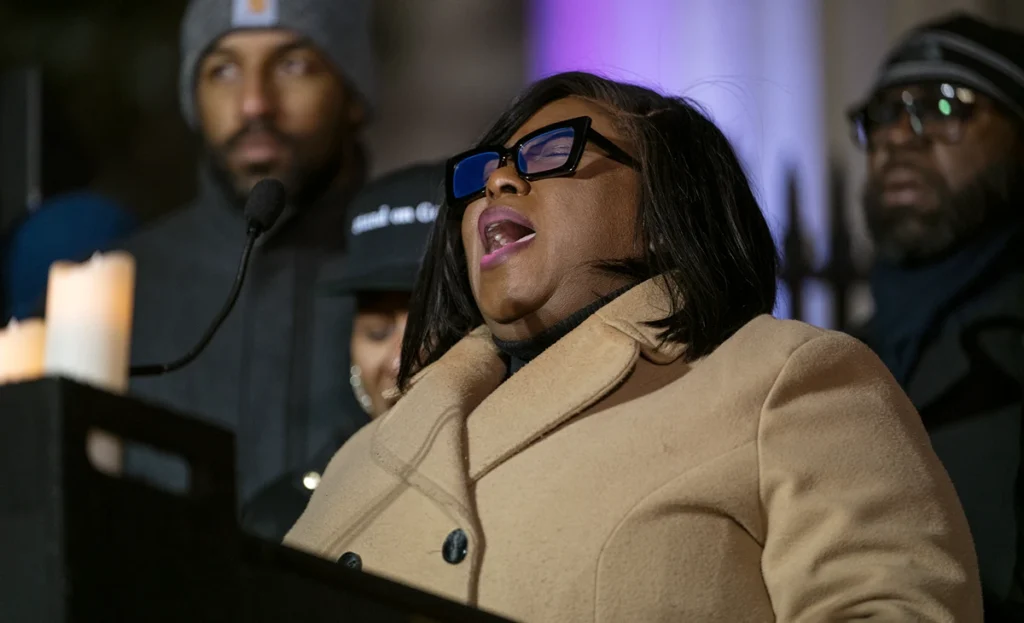Se habla español.
Interpreters available for other languages.
410-706-2781
The ROAR Center is a recognized Center at the University of Maryland, Baltimore

Photo by J.J. McQueen
On Tuesday, January 7, Mayor Brandon M. Scott, Governor Moore, city leaders, community partners, and residents gathered to mark the historic violence reductions Baltimore saw last year. This event not only marked the lowest homicide rate in nearly a decade but also set the tone for the City’s public safety priorities for 2025 and, most importantly, honored the lives lost in 2024.
The city’s annual Vigil of Remembrance memorialized the Baltimoreans lost last year to violence, overdose, suicide, and other causes as an opportunity to grieve collectively as a community. Attendees, including ROAR Center Executive Director Lydia Watts, participated in the reading of homicide victims’ names and held candles to memorialize those who passed.
Baltimore has experienced two back-to-back years of significant homicide reductions, both of the largest single-year drops in the city’s history. In 2024, the city experienced 201 homicides, a 23% decrease on top of the 20% drop in homicides Baltimore saw in 2023. Additionally, non-fatal shootings declined 34%, 414 in 2024 compared to 635 in 2023, and juvenile victims of homicides and non-fatal shootings dropped a substantial 74%.
“When ROAR opened its doors in 2019, there were many amazing and deeply committed people in Baltimore City struggling to address the enormous toll that gun violence wreaks on individuals, families, and communities,” said Watts. “But there were few public dollars or coordination—nothing that could be called an ‘ecosystem.’ ROAR jumped in to offer our areas of expertise to survivors and to weigh in on misguided policies that effectively created two tiers of survivors: those who were seen as ‘worthy’ of support and those who were subjected to racial profiling and deprived of support.
“Six years later, even with the tragedies and demands of the pandemic during those years, Baltimore City saw a historic low in shootings and homicides in 2024, the result of a myriad and sustained efforts, including ROAR’s commitment to ‘meeting clients where they are’ and walking alongside them to get to where they want to be, offering our wrap-around services of legal support, case management, nurse care management, and therapy to survivors as defined and directed by them.
“However, much remains to be done, and much of the funding that has sustained the developing ecosystem may not continue in the future. We cannot let up on the coordinated efforts that have led us to this historic reduction in harm. It could all be undone without commitment to sustained funding and coordination of efforts across ALL ecosystem sectors.”
Mayor Brandon M. Scott said, “The reductions in violence the City of Baltimore is seeing is the result of one thing: the collective work of Baltimoreans under a comprehensive strategy. These numbers would not be possible without the important work being done by the men and women at BPD, all of our partners in law enforcement, across the justice system – including the State’s Attorney, Attorney General, and US Attorney – at the state in Governor Moore and his team, with MONSE, and every community-based partner and resident working in partnership to build safer communities across Baltimore. Still, 201 lives lost is 201 too many. As we enter 2025, we note what’s working and commit ourselves to honor the memory of those we lost in 2024 by building on this progress even more in the year to come.”
“Partnership produces progress—nothing else does. The data-backed results we’ve achieved in public safety don’t happen by accident. They happen because of an all-of-the-above approach to tackling challenges head-on,” said Gov. Wes Moore. “I want to thank Mayor Scott, our law enforcement partners, State Attorneys, and community advocates for their leadership. Together, we will continue to make Maryland safer for all.”
Dr. Joseph Richardson, gun violence researcher and professor at the University of Maryland, credited Scott’s commitment to the holistic approach. Richardson also said it was important not to “get too bogged down on things unique to Baltimore.” Across the country, Richardson emphasized, social safety nets and other systems are slowly being “re-entrenched back into communities” like “before the pandemic.”
“I am proud to join Mayor Scott and Governor Moore in acknowledging another year of historic reductions in gun violence—progress that reflects the dedication and collaboration of the Baltimore Police Department, our partners, and most importantly, our community,” said BPD Commissioner Richard Worley. “While we know there is more work to be done, we look forward to honoring the lives we lost to senseless violence at the Vigil of Remembrance. BPD remains steadfast in our commitment to building trust, prioritizing community-oriented policing, and driving meaningful change that makes Baltimore safer for all and ensures residents feel safe and protected.
“As the agency overseeing Baltimore’s comprehensive violence prevention plan, MONSE has worked hand in hand with BPD, community partners, and residents to improve public safety outcomes,” said MONSE Director Stefanie Mavronis. “We are proud of the reductions in homicides that we have achieved this year as a result of our collective commitment to building a thriving Baltimore. As a City, we are proving that the public health approach to violence in our city is worthwhile, but the reality is that we’ve still lost hundreds of Baltimoreans this year from homicides, fatal overdoses, and suicide. Any life lost in Baltimore is one too many, and we will continue this work until there are no more names to be read.”